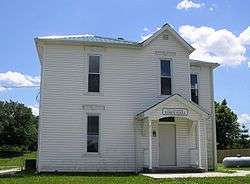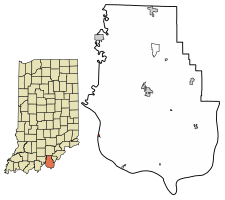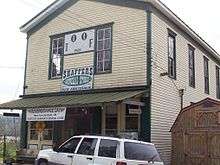New Amsterdam, Indiana
New Amsterdam is a town located in Washington Township, Harrison County, Indiana, United States, along the Ohio River. As of the 2010 census, the city population was 27.[6] It is the smallest town in Indiana.[7]
New Amsterdam, Indiana | |
|---|---|
 New Amsterdam town hall, 2007 | |
 Location of New Amsterdam in Harrison County, Indiana. | |
| Coordinates: 38°6′7″N 86°16′29″W | |
| Country | United States |
| State | Indiana |
| County | Harrison |
| Township | Washington |
| Area | |
| • Total | 0.10 sq mi (0.26 km2) |
| • Land | 0.08 sq mi (0.20 km2) |
| • Water | 0.03 sq mi (0.07 km2) |
| Elevation | 449 ft (137 m) |
| Population | |
| • Total | 27 |
| • Estimate (2019)[3] | 28 |
| • Density | 368.42/sq mi (143.11/km2) |
| Time zone | UTC-5 (Eastern (EST)) |
| • Summer (DST) | UTC-4 (EDT) |
| ZIP codes | 47142 |
| Area code(s) | 812 |
| FIPS code | 18-52398[4] |
| GNIS feature ID | 0440016[5] |
History

The first settlers in what became New Amsterdam were James Riley and Jacob Youstler. Starting in 1815, they lived in New Amsterdam for several years before relocating further north.[8] The town was formally platted on September 19, 1815, by Jacob Funk and Samuel McAdams.[9]
The town relied on the Ohio River for its growth, as it was the main transportation route for migrating settlers as well as traders up and down river. Steamboats were active on the river during the 19th century and contributed to the growth of waterfront towns. In the 1860 census, New Amsterdam was the largest town in Harrison County.
Floods played a large part in the decline of the town. The Great Ohio River flood of 1937 destroyed 75% of the structures in the town. The only original building remaining in the town is the old country store. A marker on the second story of the building shows the height of the water in the 1937 Flood.
Today, the town has a general store, a Baptist church, a Methodist church, a town hall and a cemetery.
Geography
New Amsterdam is located at 38°6′6″N 86°16′29″W (38.101894, -86.274821).[10] According to the 2010 census, New Amsterdam has a total area of 0.1 square miles (0.26 km2), of which 0.08 square miles (0.21 km2) (or 80%) is land and 0.02 square miles (0.05 km2) (or 20%) is water.[11]
Demographics
| Historical population | |||
|---|---|---|---|
| Census | Pop. | %± | |
| 1880 | 186 | — | |
| 1890 | 172 | −7.5% | |
| 1900 | 200 | 16.3% | |
| 1910 | 134 | −33.0% | |
| 1920 | 137 | 2.2% | |
| 1930 | 101 | −26.3% | |
| 1940 | 86 | −14.9% | |
| 1950 | 76 | −11.6% | |
| 1960 | 43 | −43.4% | |
| 1970 | 32 | −25.6% | |
| 1980 | 31 | −3.1% | |
| 1990 | 30 | −3.2% | |
| 2000 | 24 | −20.0% | |
| 2010 | 27 | 12.5% | |
| Est. 2019 | 28 | [3] | 3.7% |
| U.S. Decennial Census | |||
2010 census
As of the census[2] of 2010, there were 27 people, 11 households, and 8 families residing in the town. The population density was 337.5 inhabitants per square mile (130.3/km2). There were 20 housing units at an average density of 250.0 per square mile (96.5/km2). The racial makeup of the town was 85.2% White, 11.1% from other races, and 3.7% from two or more races. Hispanic or Latino of any race were 11.1% of the population.
There were 11 households of which 36.4% had children under the age of 18 living with them, 54.5% were married couples living together, 18.2% had a male householder with no wife present, and 27.3% were non-families. 27.3% of all households were made up of individuals. The average household size was 2.45 and the average family size was 2.75.
The median age in the town was 42.3 years. 29.6% of residents were under the age of 18; 0% were between the ages of 18 and 24; 25.9% were from 25 to 44; 25.9% were from 45 to 64; and 18.5% were 65 years of age or older. The gender makeup of the town was 55.6% male and 44.4% female.
Area events
The New Amsterdam Festival, also known as Remembrance Day, was held the third Saturday of April. The final year for the festival was 2014.
See also
- List of cities and towns along the Ohio River
- Ohio River flood of 1937
References
- "2019 U.S. Gazetteer Files". United States Census Bureau. Retrieved July 16, 2020.
- "U.S. Census website". United States Census Bureau. Retrieved 2012-12-11.
- "Population and Housing Unit Estimates". United States Census Bureau. May 24, 2020. Retrieved May 27, 2020.
- "U.S. Census website". United States Census Bureau. Retrieved 2008-01-31.
- "US Board on Geographic Names". United States Geological Survey. 2007-10-25. Retrieved 2008-01-31.
- "2010 City Population and Housing Occupancy Status". U.S. Census Bureau. Retrieved August 27, 2012.
- Rivero, Nicolas (25 August 2017). "The Smallest Town in Each of the 50 States". Mental Floss. Retrieved 25 June 2018.
- "Washington Township". Archived from the original on 2007-08-21. Retrieved 2008-02-11.
- Roose, William H. (1911). Indiana's Birthplace: A History of Harrison County, Indiana. Tribune Company, Printers. p. 69.
- "US Gazetteer files: 2010, 2000, and 1990". United States Census Bureau. 2011-02-12. Retrieved 2011-04-23.
- "G001 - Geographic Identifiers - 2010 Census Summary File 1". United States Census Bureau. Archived from the original on 2020-02-13. Retrieved 2015-07-17.
